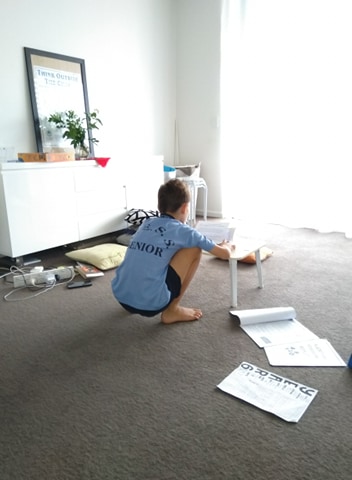
My Furniture-free Home
People have asked what does it look like to be furniture-free? So I snapped today this photo of my 11 year old doing his homework. This is our living room. He is squatting by a low table and writing. As you can see, there is nothing to see here. But let's explore a bit further.
1. What is furniture-free?
I (and Nutritious Movement) refer to furniture-free when we don't use sitting (chairs, couches), dining (traditional dining tables and chairs) or sleeping (beds) furniture.
It looks like a multifunctional room(s) with more floor space. We have been transitioning to fully furniture-free for over 5 years, and we first got rid of our couches, then beds, and lastly, our dining table and chairs. We have low, coffee tables type of surfaces, some of them can be folded and stored away, standing desks (my husband and I), a range of pillows, rollers (round and half rollers), blocks (yoga blocks that can be stacked), two bosu balls, and finally 4 traditional stools for people who can't or don't want to sit on the floor or on everything else that I just listed.
2. What are the benefits?
- I have to admit, I have always liked rooms with less things in them and more space
- When you don't have sitting furniture, you sit on the floor more often, thus having the opportunity to use many of your joints in their full (or bigger than if you were sitting in a chair) range of motion, multiple times a day.
- Not having a "device" (chair) to hold your body in an unique and specific joint configuration, allows to assume many different resting positions - maintaining each of these positions, as well as transitioning between them, provides necessary movements and loads continually throughout the day.
- These regular movements maintain your musculoskeletal, cardiovascular and lymphatic health, as well as keep the digestive and reproductive systems for example more motile and functional.
- On less nebulous and philosophical notes, that means more "exercise" (we like to call it movement), less pain, less sedenterism (as in spending less time in any one position), and in case of kids - better development.
I work with kids in tween and teen years (amongst other populations), who exhibit sedentary adaptations, despite the fact that they do sports one or several hours a week. Juxtaposing even 5 hours a week of structured practice to the rest 163 hours (of which, you might be sleeping for lets say 50 hours) gives us at least 60 hours a week spent in essentially the same one position (sitting in a chair/couch), for work/school, commute, eating, resting, hanging out with friends etc - more than half of your awake time.
This is no good news for all the other positions, including upright and walking. The floor provides many more opportunities for several positions, loads and adaptations, that get carried over to other activities.
3. What are the downsides?
- Well, for starters, people think that we are weird, even when they don't say it.
- When we have people over, I mostly notice that they don't feel comfortable (but usually refuse to be helped by using pillows and other props that will adjust "the floor" to their bodies).
- It sure makes for lots of eyerolls, but I still think that the benefits outweigh the eyerolls!
4. What else?
- Most of the benefits of furniture-free can be experienced without getting rid of your sitting furniture, at least at the beginning. One step ahead is to start sitting with a neutral pelvis, using the back rest less, and getting up every 30 minutes. For most people this is already enough movement input to see differences over the long run. The next step would be to start slightly lowering your sitting surfaces. I'm organising 3 workshops at the moment that are all going to educate and provide opportunities to practise the different "ingredients" of being able to use your body more with less effort.